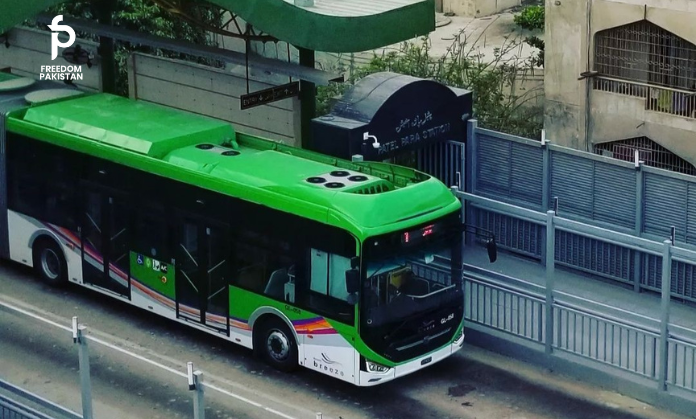Sindh Govt Invests Over Rs. 50 Billion in New Karachi Bus Routes
Introduction
In a historic move to modernize Karachi’s struggling transport system, the Sindh government has announced a massive investment exceeding Rs. 50 billion to introduce new bus routes across the city. This project, part of the 2025–26 provincial development budget, aims to alleviate traffic congestion, reduce pollution, and provide affordable transportation for millions of Karachiites. With this initiative, the Sindh government signals a strong commitment to sustainable urban mobility and public welfare.
Background of Karachi’s Transport Crisis
Karachi, Pakistan’s most populous city, has long struggled with poor public transport. Over 20 million residents rely on an outdated and overburdened system. The city’s roads are dominated by private vehicles, rickshaws, and poorly maintained minibuses, leading to traffic jams, road accidents, and growing frustration among commuters. In the past, several attempts to improve public transport, such as the Karachi Circular Railway and private partnerships, either failed or yielded limited results.
Due to decades of neglect, a reliable mass transit system remains absent. The need for an affordable, accessible, and eco-friendly transportation network has never been more urgent. The Sindh government’s current investment seeks to fill this gap by launching a robust and comprehensive bus network in Karachi.
Key Features of the New Bus Routes
The new bus initiative will cover major areas of Karachi, aiming to integrate different parts of the city under a unified public transport system. A total of over 100 new bus routes are planned, connecting key commercial hubs, residential neighborhoods, and industrial zones. These include areas like Korangi, North Karachi, Clifton, Malir, Gulshan-e-Iqbal, Orangi Town, and more.
The project will include various types of buses, such as standard diesel buses, hybrid buses, and most importantly, electric buses. The routes are designed to reduce commute times and ensure greater frequency of service, especially during peak hours. Passenger convenience and safety are core elements of the design, with features such as modern bus terminals, real-time tracking apps, security cameras, and priority lanes.
Allocation of the Rs. 50 Billion Budget
The Sindh government’s transport budget allocation for Karachi includes over Rs. 50 billion dedicated to this project. The funding breakdown includes:
-
Rs. 22 billion for the procurement of new buses
-
Rs. 15 billion for road infrastructure and bus lanes
-
Rs. 8 billion for construction of terminals and depots
-
Rs. 5 billion for technological upgrades including smart ticketing and tracking systems
This investment also encourages collaboration through public-private partnerships (PPPs). Several international and local companies have expressed interest in co-developing transport infrastructure under the government’s regulation. The project will be rolled out in phases over the next three years, with the first fleet of buses expected to hit the roads by the end of 2025.
Focus on Electric and Eco-Friendly Buses
One of the most revolutionary aspects of the new transport system is the inclusion of electric buses. Out of the total investment, a significant portion is dedicated to launching over 500 electric buses in Karachi. These buses are not only cost-effective in the long run but also environmentally friendly, helping to reduce the city’s carbon footprint.
To support this green initiative, the government plans to build multiple electric charging stations across the city. These will be strategically located in high-traffic areas, terminals, and bus depots. The move supports Pakistan’s broader commitment to combating climate change and aligns with global environmental goals.
FBR to Hire Retired Army Soldiers for Tax Enforcement
Expected Benefits for Karachi Residents
The launch of the new bus routes brings a host of benefits for Karachi’s residents. Most importantly, it will provide affordable and safe transportation to millions who currently rely on expensive private options or unsafe minibuses. The daily commute for students, office workers, and laborers will become easier and faster.
Some key benefits include:
-
Reduced travel time due to dedicated bus lanes and frequent schedules
-
Lower transport costs for low and middle-income groups
-
Improved road safety through regulation and better-maintained vehicles
-
Employment generation in the form of drivers, technicians, and support staff
-
Boost to local economy as mobility increases productivity
By easing mobility, the initiative will indirectly benefit various sectors, including education, healthcare, and retail. People will be able to travel farther and faster, helping improve access to opportunities across the city.
Challenges and Risks
Despite its promising goals, the project does come with certain challenges. One of the main hurdles is Karachi’s weak infrastructure. Many roads are narrow, damaged, or lack proper signage. Creating dedicated lanes for buses will require not only investment but also effective urban planning.
Another challenge is project execution and management. Previous initiatives in Karachi have faced delays, corruption, and lack of coordination between departments. Ensuring timely delivery will require strong political will and transparent governance.
Operational sustainability is also a concern. Maintaining such a large fleet, especially electric buses, demands continuous funding, technical expertise, and an efficient management system. The government must ensure that routes remain active, buses are well-maintained, and services remain consistent.
Role of Sindh Mass Transit Authority
The Sindh Mass Transit Authority (SMTA) will serve as the central body overseeing this project. The authority is responsible for planning, coordination, and implementation of all mass transit projects in the province. In this case, SMTA will work closely with Karachi’s local government, transport department, and private partners.
SMTA will ensure the routes are properly mapped, schedules are maintained, and the buses meet required safety and emission standards. The authority will also launch a digital platform for route maps, e-ticketing, real-time tracking, and commuter feedback. This will make the system user-friendly and efficient.
Public Reactions and Expert Opinions
The announcement has been widely welcomed by the public and transport experts. Karachi’s residents, who face daily travel difficulties, have expressed hope that the new system will finally bring relief. Students and office workers are especially optimistic about improved convenience and cost savings.
Urban planning experts have applauded the focus on electric buses and environmental sustainability. According to Dr. Saima Hasan, a transportation analyst, “This is a major step toward transforming Karachi’s image from a traffic-clogged city to a modern metropolitan hub.”
However, some opposition politicians have raised concerns about potential mismanagement and the government’s track record with past projects. They demand full transparency in tenders, contractor selection, and regular audits.
Conclusion
The Sindh government’s decision to invest over Rs. 50 billion in Karachi’s bus system marks a turning point in the city’s transport history. By focusing on electric buses, smart routes, and public convenience, this initiative promises to transform urban mobility in the country’s largest city.
While challenges remain in terms of infrastructure and execution, the project holds the potential to provide long-term solutions to Karachi’s transport problems. With proper oversight, efficient management, and continued investment, Karachi could finally achieve the modern, eco-friendly public transport system its people deserve.




